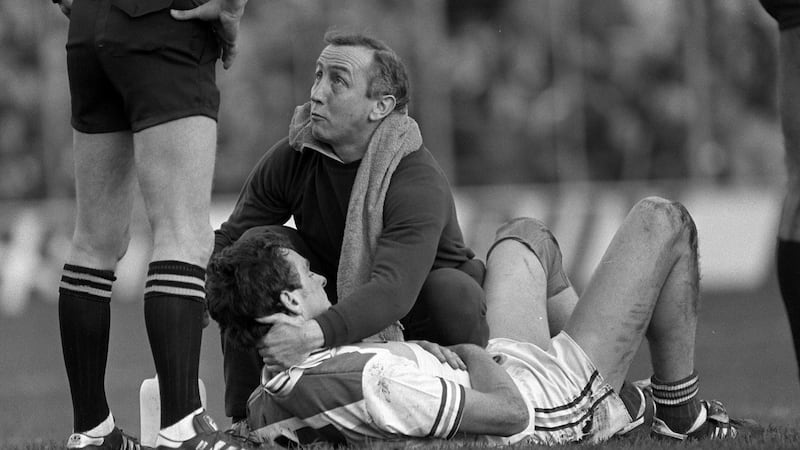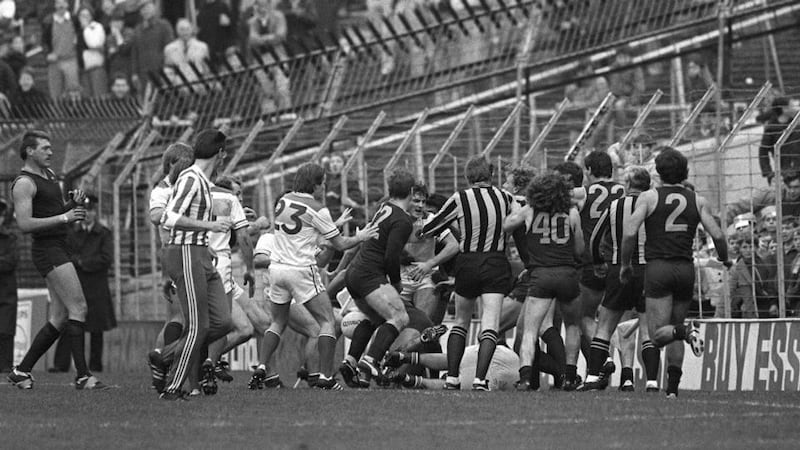For an event whose attendant publicity had laboured metaphors of marriage and coming together, the very first international rules Test turned out to require a different set of vows altogether.
This evening at Croke Park Ireland and Australia mark the 31st anniversary of that inaugural series. The international project has been through so many twists and turns, crises and attempted resolutions that it's hard to remember when it was new and fresh and envisaged its future in the most optimistic of terms.
It’s 25 years since the first manifestation of the international series petered out and slipped into an eight-year hibernation before emerging as what we have today – something subscribed to by both games organisations, the GAA and AFL, even if it is currently reduced to one-Test series and faltering public support.


In the years between 1984 and 1990, however, the hybrid game fizzed and sparked intermittently. Often the attention it attracted was for eye-boggling scenes of random violence but there was also a narrative at its heart: amateur Gaelic footballers going up against professional Aussie rules players and when it clicked competitively there was genuine excitement.
The project had its genesis in a report commissioned by the GAA to look into the possibility of establishing a series between the two great indigenous football games.
Exhibition matches
That in turn had been inspired by freelance efforts by significant figures in the Australian game, like Harry Beitzel and Ron Barassi,and Meath's Peter McDermott in bringing teams to Ireland and Australia to play exhibition matches during which the Australians' aptitude with the round ball planted the seed of the possibilities of a hybrid game.
The first series was agreed for the GAA's centenary in 1984. It would be played over three Tests and there would also be two midweek practice matches. The first of these was played in Galway against a Connacht selection, with the home team winning 68-54 against a subdued Australian side.
Ireland and Connacht coach Liam Sammon had an inkling that had the match been a horse race it would have prompted a stewards' enquiry. One way or the other the first Test in Cork's Páirc Uí Chaoimh turned out rather differently.
Noel Roche, one of the pioneering international players – he held the record number (10) of Ireland caps during the first phase of the series – remembers how early in the Test it was obvious the rules of engagement had changed. The Clare footballer had also played for the Connacht selection and Sammon's warning is still clear in his head.
“We had a warm-up match in Galway,” says Roche,”and had no trouble, either from violence or on the football front. I remember Liam Sammon saying, ‘lads what ye were playing out there will bear no relation to what’s coming. He was right. I remember it wasn’t a great day and the crowd wasn’t very big.
"Then after only three or four minutes when the dust had settled I looked around and there was PJ Buckley on the ground. He had to be stretchered off. Later on, Mick Lyons as well – I mean they were two tough men. You knew then what was happening. Everyone was looking on and saying, 'what's going on?' We were all looking over our shoulders when we were going for the ball, when we were on the ball and when we were just standing there – expecting something to come around the corner!"
Writing in this newspaper the late Paddy Downey reported: "The match was excessively physical and in the third quarter erupted into a free-for-all which embroiled most of the players on both sides and a few intruders – substitutes and officials – from the sideline.
"The Australians appeared to ignore the agreed rules governing the tackle and frequently pulled down opponents in possession of the ball. The short-arm tackle was used a few times with unfortunate results for the Irish full back Mick Lyons and substitute John Costello, who were taken from the field with concussion."
Despite the mayhem and a 57-70 defeat Ireland, before a crowd of 8,000, resisted as best they could. “The indefatigable Jack O’Shea was a hero of the Irish team in spite of the heavy knock he received early in the first quarter,” wrote Downey.
O'Shea captained Ireland for the first two series in 1984 and Down Under two years later. He was one of the great international performers in those early years, winning the Harry Beitzel medal for best player in a series in 1990.
“I went into the game ready to play a game of football,” said O’Shea,”but it turned out to be very robust. I think they saw it as a professionals-versus-amateurs thing and that they were much better athletes and were getting that message across but it was over-the-top on a few occasions. There was a lot made of it at the time. The warnings went out that the series wouldn’t continue.
Bit of arrogance
“Gary McIntosh, their goalkeeper, was out any time there was anything happening. It cooled off for the second and third Tests – although it stayed fairly lively – but I think there was still a bit of arrogance there. I think that changed down the years and their players were less huge and more mobile. It was violent. Our game was tough, particularly back then but this was dangerous.”
The GAA’s displeasure at what had happened was made clear but there were also underlying Australian concerns. They had already made concessions on the shape of the ball and if the mark and bewildering speed of their inter-change were an advantage to them, the tackle was not the one familiar from subsequent contests in that it was more restrictive.
Dr Allen Aylett, president on the NFL Australia, whose talent for phrase-making soundtracks the first series, came up with some ingenious advocacy to convince the hosts of the fuller-on tackle's merits.
“It is illogical that the player in possession of the ball cannot be challenged with a fair tackle. There must be a fight-back. Putting it on another plane, Irish history is surely an example of what that means. You don’t give in to an adversary without a challenge.”
That argument was ultimately won and by 1986, the pull-down tackle was incorporated into the international rules.
One influential figure wasn’t, however, impressed by the argument that rules confusion lay at the heart of Australian behaviour in the first Test.
It won't surprise anyone with even a passing knowledge of GAA jurisprudence that one of those who drew up the rules for the international game was Cork county secretary Frank Murphy.
In addition – having been a top hurling referee in the 1970s and taken charge of All-Ireland finals – he was asked to officiate at the first Test in Cork, along with Australian umpire Rowan Sawers.
“The first game undoubtedly left a lot to be desired,” Murphy says. “There were violent actions out of the blue, which didn’t add to the lustre of the ‘marriage’.
“I wouldn’t have said that the rules were the cause of the incidents. You had to conclude that they were pre-mediated. There was a feeling that those all-in incidents – not inflicting injury but dust-ups – were part of the Australian psyche at the time.”
One problem that was avoided related to match protocol. There had been concern about the anthem to be played before the first game because Denis Conroy (the at times volcanically irascible Cork chair) expressed misgivings about God Save The Queen being played. In the event, the No 2 Army Band played Advance Australia Fair, which earlier that year had been officially adopted as the national anthem.
Paddy Downey wrote that “temperate criticism” of delinquent individuals was necessary but “not the strident, sometimes hysterical, criticism of the whole team and by implication the whole touring party”.
A week later the landscape changed when Ireland won the second Test 80-76 in Croke Park before 18,470. In what was the internationals’ first example of Ireland’s humour brightening up considerably after a win, the project was greeted with much more enthusiasm, as the series would now go into its third Test with the verdict open.
O’Shea most caught the Australians’ collective eye. He denies the contemporary reports that he had been showered with offers from rules’ clubs.
“I didn’t actually get approached to be fair. I think when the Australians were asked what Irish players they thought might make it, some mentioned me, but there were never any offers. I was 27 by then and too old to be switching games.”
The third Test was a great success. The tourists wrapped up the series after a 76-71 win in a match that still featured some startling interventions, including the Australian “bench clearance” when all inter-change players rushed off the bench to involve themselves in whatever fracas erupted, but overall the match was exciting and drew a fine crowd of 33,280.
It was the start of something enduring. Frank Murphy travelled privately for the 1986 series and was invited to chair the disciplinary tribunal, whose procedures so impressed him that he was involved in recommending similar structures for the GAA in the years to come.
O'Shea made friends with some of the Australians and remembers his international career with fondness. "I did enjoy playing it because I was playing with fellas who'd never get to an All-Ireland, like Noel Roche, Kevin O'Brien and Spike Fagan because of where they were from. But the game was mobile and if you were that kind of player it suited you."
Pioneering days
Roche was one of those players and although his career lasted long enough to see him win an historic Munster medal with Clare in 1992, he remains closely associated with the pioneering days of international rules.
“My fitness level was high,” he says when asked what equipped him the hybrid game so well, “even if I wasn’t the most skilful player and I never backed down from a challenge. If it was only in the square in Kilkee I’d be very competitive and often playing fellas bigger than me!”
The final word goes to Dr Aylett, who memorably enthused about the game after the second Test.
“Rome wasn’t built in a day nor do oaks grow quickly from little acorns but from what we’ve seen here today I’m certain that in this new game we’ve got a space-age spectacular.
“There are five established major football games in the world but this is twice as fast as any of them. I enjoyed this as much as any match I’ve seen for a long time.”













